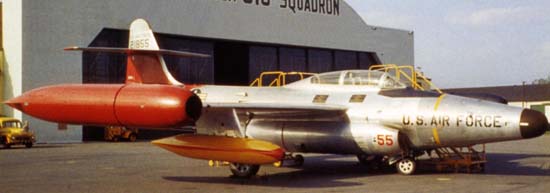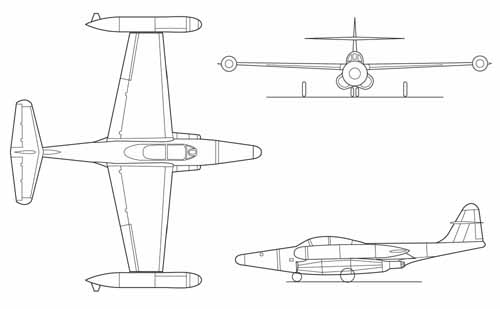_
|
AIRCRAFT |
|
|
|
NORTHROP F-89 SCORPION |
|
|
|
|
 |
|
|
|
|
|
The Northrop F-89
Scorpion was a twin-engine, all-weather fighter-interceptor
designed to locate, intercept, and destroy enemy aircraft by day
or night under all types of weather conditions. One of the most
heavily armed fighter aircraft, the F-89 was the backbone of the
North American Air Defense Command until newer interceptors
became available. The F-89 helped the USAF’s Air Defense Command
to patrol the skies during the period when Soviet
intercontinental bombers first became a threat.
|
|
|
|
The first F-89 made its
initial flight in August 1948 and deliveries to the Air Force
began in July 1950. The F-89 received its name during
testing at Muroc Dry Lake (today's Edwards AFB) after crews
remarked that the interceptor looked like a scorpion ready to
strike. The name stuck and was later officially recognized by
the Air Force.
|
|
|
|
The F-89 was the first
multi-seat, all-weather jet interceptor and was the first
aircraft designed to carry an all-rocket armament. At the time
of its production, the F-89 had an advanced radar system
enabling the radar operator (rear cockpit) to guide the pilot
into proper attack position to
engage hostile bombers in any weather.
|
|
|
|
Only eighteen F-89As were completed, which were mainly used for
tests and trials, before the type was upgraded to
F-89B standard,
with new avionics. The type entered service in June 1951. These
had considerable problems with engines and other systems, and
soon gave way to the
F-89C. Despite repeated engine changes, problems
persisted, compounded by the discovery of structural problems
with the wings that led to the grounding of the F-89 and forced
a refit of 194 -A, -B, and -C models.
|
|
|
|
The major production model was the
F-89D, which
first flew 23 October 1951 and entered service in 1954. It
removed the cannon in favor of a new Hughes E-6 fire control
system with AN/APG-40 radar and an AN/APA-84 computer. Armament
was two pods of 52 2.75in "Mighty Mouse" folding fin aerial
rockets (FFAR), for a total of 104.
A total of 682 were
built.
|
|
|
|
Proposed re-engined F-89s, designated
F-89E and
F-89F, were not
built, nor was a proposed
F-89G that would
have used Hughes MA-1 fire control and GAR-1/GAR-2 (later AIM-4)
Falcon air-to-air missiles like the F-102 Delta Dagger.
|
|
|
|
The subsequent F-89H,
which entered service in 1956, had an E-9 fire control system
like that of the early F-102 and massive new wingtip pods each
holding three Falcons (usually three semi-active radar homing
GAR-1s and three infrared GAR-2s) and 21 2.75in "Mighty Mouse"
rockets, for a total of six missiles and 42 rockets. Problems
with the fire control system delayed the -H's entry into
service, by which time its performance was notably inferior to
newer supersonic interceptors, so it was phased out of USAF
service by 1959.
|
|
|
|
The final variant was the
F-89J. This was
based on the F-89D, but replaced the standard wingtip missile
pod/tanks with 600 gal (2,271 l) fuel tanks and fitted a pylon
under each wing for a single MB-1 Genie nuclear rocket
(sometimes supplemented by up to four conventional Falcon
air-to-air missiles). There were no new-build F-89Js, but 350
-Ds were modified to this standard. They served with the Air
Defense Command, later renamed the Aerospace Defense Command
(ADC), through 1959 and with ADC-gained units of the Air
National Guard through 1969. This version of the aircraft was
extensively used within the Semi Automatic Ground Environment
(SAGE) air defense system.
|
|
|
|
On July 19, 1957, a
Genie test rocket was fired from an F-89J during
John Shot of Operation Plumbob, the first and only
time in history that an air-to-air rocket with a nuclear warhead
was launched and detonated. Three hundred and fifty F-89Ds
were converted to "J" models which became the Air Defense
Command's first fighter-interceptor to carry nuclear armament .
|
|
|
|
The F-89 entered
service with the 84th Fighter-Interceptor Squadron of the 78th
Fighter-Interceptor Group based at Hamilton AFB, CA in June of
1951. A total of 1,178 F-89 were produced and flew with both
Active and ANG Squadrons. Scorpions also flew with 2 active (321
FIS, Paine AFB, WA; 497th FIS, Portland IAP) and 2 ANG
(116th FIS at
Spokane IAP, WA; 123 rd FIS, Portland IAP, OR) squadrons assign
to the 25th Air Division, and also with the 318 FIS during the
squadrons assignment to Presque Isle, ME from August 1954
through August 1955.
|
|
|
|
The last Scorpion
(F-89J S/N 52-1896) left operational service with Maine ANG’s
132rd FIS in 1969.
|
|
|
|
|
SPECIFICATIONS |
|
|
 |
|
NORTHROP F-89D SCORPION |
|
|
TYPE:
Long range Interceptor
POWER:
Two
Allison J35s turbojets of 7,200 lbs. thrust each with
afterburner
SPEED:
636 mph at 10,600 feet, 523 mph at 46,500 feet
RANGE:
1,600 miles
SERVICE
CEILING: 49,000 feet
WEIGHT:
Empty - 25,194 lbs, Combat - 37,190 lbs, Gross - 42,241 lbs
, Max T/O 46,789 lbs.
DIMENSIONS: Wingspan 59 ft 8 in, Length 53 ft 10 in, Height 17 ft 6 in
ARMAMENT:
(F-89D) Armed with 104 2.75-inch folding fin unguided
rockets in wingtip pods. Underwing racks could carry 16
five-inch rockets (F-89H) a combination of
Two
AIR-2A Genie air-to-air rockets with nuclear warheads plus
four or six AIM-4C Falcon missiles or 42 2.75-inch
folding fin unguided rockets.
CREW:
Two (Pilot & Radar Observer)
PRODUCTION TOTALS: 1,178
-
18
(F-89A); 37
(F-89B);
152
(F-89C);
682
(F-89D);
156
(F-89H)
COST:
$1,009,000
318th FIGHTER-INTERCEPTOR
SQUADRON SERVICE:
5
August 1954
– 18 August 1955 at
Presque Island AFB Maine,
|
|
|
|
COURTESY OF THE McCHORD AIR MUSEUM |
|
|
|
|
 |
|